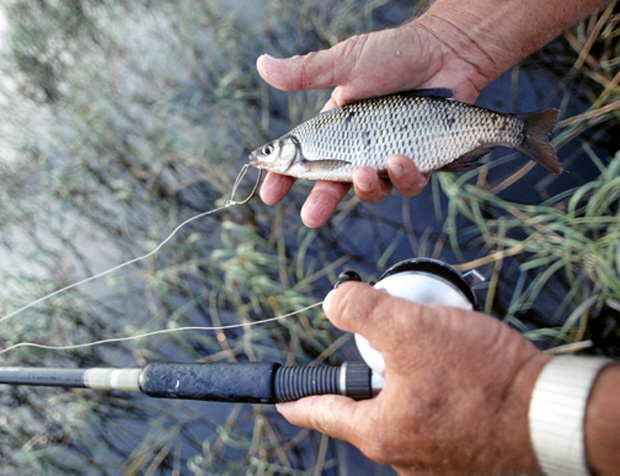July 09, 2014
By Frank Sargeant
Florida-grown livies are still the killers for trophy fish.
 Weedless kahle hooke for swimming the shiner through hyacinth and other heavy cover.
Weedless kahle hooke for swimming the shiner through hyacinth and other heavy cover.
As summer doldrums give way to cooler weather, undoubtedly many anglers are making plans to hit that magic number, if they haven't already: a double-digit largemouth bass, 10 pounds.
We've got plastic worms, spinnerbaits, topwater toads and all kinds of monster killers, but the closest thing to a can't-miss is a live wild shiner.
Fishing shiners is not brain surgery, to be sure; get a heavy rig, impale a 5- to 8-inch shiner on a 5/0 or larger kahle-style hook and put it in harm's way, around emergent cover, hydrilla pockets or spawning beds, then hang on. The bass will handle the rest.
But there are some tricks to every trade. Some of the best were taught to me by a group of crusty old Salt Springs guides who operated under the logo “Bass Champions” some 30 years ago. They're still just as effective today for a younger generation of guides, such as Sean Rush, who as this is written is bringing almost 50 bass per day to the boat at Rodman Reservoir northeast of Ocala, and who guided clients to dozens of 10-pound-plus fish last year.
 Captain Sean Rush lips a Rodman Reservoir Bass.
Captain Sean Rush lips a Rodman Reservoir Bass.
- First, shiners can be fished lip-hooked, tail-hooked or dorsally-hooked. Traditional rigging for spots around floating hyacinth and maidencane is a hookup through both lips, with the bait suspended 18 inches or more under a cork big enough that the shiner can't hold it down. This lets the shiner swim along the edge of the cover while the bobber acts as a “stop” to keep him from getting too deeply into the weeds and also helps the angler keep track of the bait—it's best for those not experienced in fishing live shiners.
- Second rigging puts the hook in just ahead of the dorsal fin. This is the usual hookup for drifting a shiner deep along an old river channel or in a spring hole; it helps to keep him following the drift of the boat, and also helps to keep him deep. A small sinker is sometimes added a foot above the bait.
- Tail-hooking can be the ticket when the bass are deep in heavy cover. Often a weedless hook is used for this rigging because the idea is to send the shiner in there where the sun don't shine—a properly handled shiner will sometimes swim 30 feet back under a hyacinth drift with this rigging. Of course, getting out the bass that eats him is a whole other world of problems, but you'll surely get strikes from fish that never see a bait otherwise.
Tackle is critical to handling the big baits and the heavy cover where they work best. Most pros use stout rods 7 to 8 feet long with power adequate for whipping king mackerel. Baitcasters loaded with 20-pound-test line or more, sometimes with 65-pound-braid, do the job of setting the big hooks and jerking the fish clear. (No, it's not very sporting—but neither is leaving a hook broken off in a fish's mouth; better to use equipment suited to the job, land the fish quickly, take a photo and then send her on her way.)
Keeping shiners lively is worth a whole article in itself, but basically it requires a large livewell with loads of aeration—a little bubble-stone won't do it—and water kept cool by adding ice frozen inside a milk jug every now and then. Many anglers also add a salt-mix that seems to help the baits survive, as well.
Wild shiners are available at baitshops around most big Florida bassing lakes. They're expensive, at $12 to $18 per dozen, but just about every bait is likely to earn an oversized bass. You can also catch your own with hair hooks and breadballs in farm ponds and grove lakes if you have access. And many bait dealers sell domestic shiners, which cost less but are less lively and less attractive to bass, for quite a bit less than the wild baits. FS

